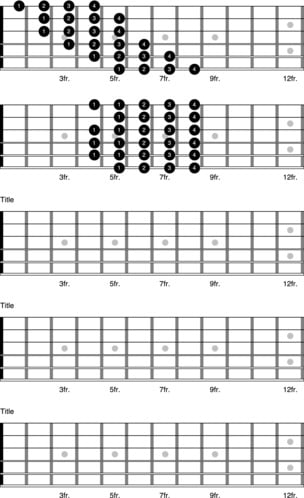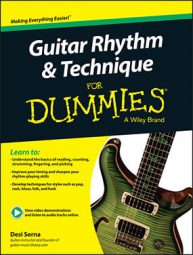Use these techniques to review your basic rhythms and warm up your hands at the beginning of a playing session. Before you begin, trim and file the nails on your fretting hand so that nothing comes between your fingertips and the strings.
Also, you may need a warm up before your warm up. Make sure your shoulders, arms, hands, and fingers are loose and warm. Stretch and massage yourself to get the blood flowing if need be.
Playing a rhythm pyramid
A rhythm pyramid, like the one below, is the most basic way in which a measure of music is subdivided. For practice, you can strum the different note values on open strings, chord shapes, or muted strings.
Set your metronome to 80 beats per minute, give or take, and spend a few minutes alternating between quarter, eighth, and sixteenth notes.
It’s a good idea to count out loud, like this: “1 2 3 4, 1 and 2 and 3 and 4 and, 1-e-and-a, 2-e-and-a, 3-e-and-a, 4-e-and-a,” and so on.
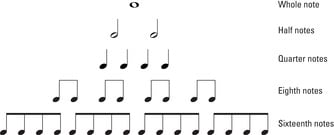
The following figure shows you the rest equivalents to the notes in the previous figure. As you practice strumming rhythms, place rests into your playing as well.

Warming up with alternate picking
The following figure is good for working on alternate guitar picking and getting to know the placement of the strings under your picking hand.
Set your metronome to a comfortable tempo and rehearse the figure for a minute or two. Aside from moving across the strings in the two directions shown, you can use random movement and skip strings.
To sound more musical, hold down a chord shape with your fretting hand. For more of a challenge, the same exercise can be played using sixteenth notes.
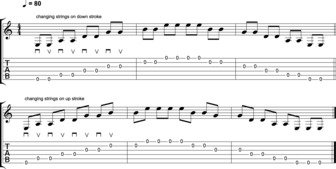
Warming up with fingerpicking
The following figure gets the blood flowing in your fretting-hand fingers. You can practice the fingerpicking pattern by playing at various tempos and over different types of chord progressions.
Try changing the pattern by reversing the order of your fingers. Reversing your fingers, but still starting with the thumb is another option.

The Spanish fingering system
In traditional guitar notation, the letters p, i, m, and a are used to refer to the fingers on the picking hand. Taken from the Spanish language, here’s what the letters represent:
-
p = pulgar (thumb)
-
i = indice (index or first finger)
-
m = medio (middle or second finger)
-
a = anular (ring or third finger)
Below is a visual example of this Spanish fingering system. Occasionally, you come across pimac, where the letter c stands for chico, the pinky finger.
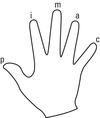
Playing a chromatic-scale pattern
Playing a chromatic-scale pattern is great way to exercise all four fingers on your fretting hand. In the following figure, you see two examples. The numbers indicate which fingers to use. Use alternate picking as you play up and down each chromatic pattern in order to improve the synchronization of both hands.
To challenge your fretting hand more, use hammer-ons as you ascend the pattern and pull-offs as you descend, picking only the first note on each string.
You can practice at your own pace, or confine your playing to eighth or sixteenth notes while following a metronome. These chromatic patterns can be moved around the neck and started at any fret.
